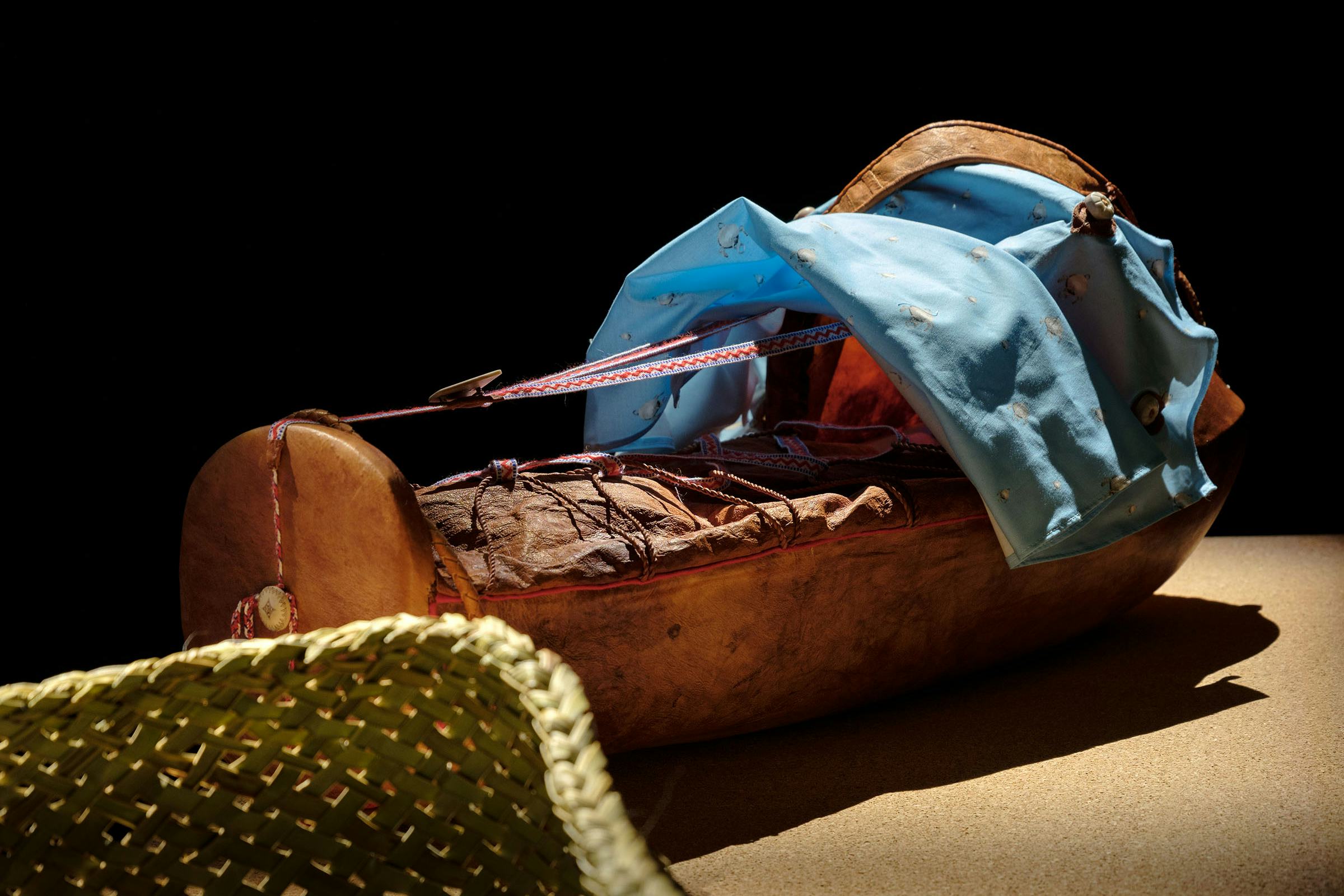LB°24 — Participants
ArchiveArchitecture of Aroha is a collaborative project that explores indigenous practices in Aotearoa New Zealand and Sápmi.
Architecture of Aroha is a collaboration between Gunvor Guttorm, Berit Kristine Andersen Guvsám, Inga Ravne Eira, Tanya White, and Jasmine Te Hira, curated by Zoe Black. The project unfolds a dialogue between two objects that hold important cultural significance: the wahakura and the gietkka, baby sleeping vessels from Māori and Sámi communities respectively. Within these Indigenous groups, the making of the baby cradle and its materiality is more than a craft, it's a school of ancestral wisdom about care and love and the interconnected world that brings nature, the land, the makers, the families, the ancestors, and the extended community together.
On view on at Konsthallen Kulturens Hus, Luleå
Architecture of Aroha, 2023
Wood, harakeke, animal hides, wool, plant material, moving image and public program.
The wahakura is a cradle from te ao Māori, the world view of the Indigenous people of Aotearoa New Zealand, woven from harakeke – a plant with long sword-like fronds, similar to flax.
The gietkka is the cradle of the Indigenous Sámi people of regions across Norway, Sweden, Finland, and parts of Russia. The gietkka is crafted using found natural materials, with the form carved from timber that is then covered with hides, often reindeer, and embellished to reflect family connections and ancestral knowledge.
The design of both the wahakura and the gietkka reflect a deep understanding of the natural world. For each, materials are sourced locally to echo the rhythms of the environment and show the connection between all aspects of life and land for Indigenous peoples.
The sleeping vessel’s innovation does not only lie in their complex technology and design but in the thoughtful consideration of the baby's well-being within the context of community life as a whole. Respectively, the wahakura and the gietkka embody the essence and resilience of Sámi and Māori thinking and the continuous relationships to the past, present, and future.
Architecture of Aroha is an installation composed of two gietkka and two wahakura, alongside films showcasing the process of their making. The exhibition space is imagined as an intimate meeting ground where both communities share understanding and pass down knowledge. A series of workshops and talks will be hosted during the biennial's closing week, bringing together Māori and Sámi practitioners and knowledge holders.
Credits films
Wahakura film by Emily Parr
Gietkka film by Karl-Oskar Gustafsson
Architecture of Aroha brings together
Berit Kristine Guvsám (b. 1986, Steinkjer, Norway) is a duodjár who grew up in Steinkjer but also has connections to Divtasvuodna in the Lule Sámi area. Guvsám holds a master's degree in duodje from the Sámi University of Applied Sciences. Within the duodje field, she works with soft materials such as textiles and leather. Traditional duodje from the Lule Sámi area is the base of her practice.
Gunvor Guttorm (b. 1958, Karasjok, Norway), a Professor in duodji (Sámi arts and crafts, traditional art, applied art) at Sámi allaskuvla/Sámi University of Applied Sciences, Guovdageaidnu, NO. She has taught both undergraduate and graduate courses in duodji at Sámi University College, both practically and theoretically, and has produced several essays on how the traditional knowledge of Sámi art and craft is transformed to the modern lifestyle.
Iŋgos-Máhte Iŋgá, Inga Ravna Eira (b. 1948, Karasjok, Norway) is a writer, teacher and translator based in Karasjok, NO. She writes poetry, short stories and children's books in Northern Sami. Together with other artists, she has worked with performance shows and she has performed self-written poems in the musical poetry performance Čuollogeađgi (The Silhouette Stone).
Jasmine Te Hira (b. 1990, Aotearoa New Zealand) is an artist, arts educator and community partnership coordinator. Te Hira has forged a practice that articulates concepts relating to time, memory and perception through the boundaries of object, video and constructed space.
Tanya Reihana White (b. 1965, Aotearoa New Zealand) is a kairaranga (weaver) based in Tāmaki Makaurau Auckland and a descendant of the tribes of Ngāti Whātua, Ngāti Hineāmaru and Ngāti Maniapoto. As a practitioner for many years, her focus has been on the integration of health and wellbeing between people and the land. Tanya’s master’s degree focused on mokopuna (the grandchild) wellbeing through the healing practices and tikanga (ways of being and doing) of raranga wahakura (weaving safe sleeping vessels for newborn infants). Her current role is based at Te Whare Wānanga o Wairaka, as Kaitiaki Taiao.
Zoe Black (b. 1985, Aotearoa New Zealand) is a curator and the deputy director of Objectspace in Tāmaki Makaurau Auckland, NZ. Her curatorial practice has focused on community development and advocating for critically under-represented craft and object art forms.
With thanks to
Karl-Oskar Gustafsson
Manaia Kolio
Emily Parr
Nikau Reihana-Wallis
Mikael Pirak
Ove Stødle
Supported by
Nordic Culture Fund
IASPIS
Objectspace
Norwegian Crafts
Sámi allaskuvla / Sámi University of Applied Sciences.
